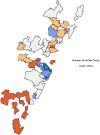Spatial variations in STIs among women enrolled in HIV prevention clinical trials in Durban, KwaZulu-Natal, South Africa
- PMID: 36995287
- PMCID: PMC10064823
- DOI: 10.1080/17290376.2023.2193238
Spatial variations in STIs among women enrolled in HIV prevention clinical trials in Durban, KwaZulu-Natal, South Africa
Abstract
South Africa is faced with a high HIV and STI prevalence and incidence, respectively, with pockets of high burden areas driving these diseases. Localised monitoring of the HIV epidemic and STI endemic would enable more effective targeted prevention strategies. We assessed spatial variations in curable STI incidence among a cohort of women enrolled in HIV prevention clinical trials between 2002 and 2012. STI incidence rates from 7557 South African women enrolled in five HIV prevention trials were geo-mapped using participant household GPS coordinates. Age and period standardised incidence rates were calculated for 43 recruitment areas and Bayesian conditional autoregressive areal spatial regression (CAR) was used to identify significant patterns and spatial patterns of STI infections in recruitment communities. Overall age and period standardised STI incidence rate were estimated as 15 per 100 PY and ranged from 6 to 24 per 100 PY. We identified five significant STI high risk areas with higher-than-expected incidence of STIs located centrally (three-locations) and southern neighbouring areas of Durban (two-locations). Younger age (<25), not married/cohabitating, parity <3 and poor education were all significant correlates of high STI communities. Findings demonstrate sustained STI incidence rates across the greater Durban area. The role of STI incidence in HIV acquisition in high HIV endemic areas need to be revisited as current highly effective PrEP interventions do not protect from STI acquisition. In these settings there is an urgent need for integrative HIV and STI prevention and treatment services.
Keywords: HIV; STI; South Africa; incidence; mapping; spatial epidemiology.
Conflict of interest statement
No potential conflict of interest was reported by the author(s).
Figures
Similar articles
-
A decade of sustained geographic spread of HIV infections among women in Durban, South Africa.BMC Infect Dis. 2019 Jun 7;19(1):500. doi: 10.1186/s12879-019-4080-6. BMC Infect Dis. 2019. PMID: 31174475 Free PMC article.
-
Quantifying Vulnerabilities of Single Women and Sexually Transmitted Infections in South Africa (2002-2016): Is It Getting Better (or Worse)?Arch Sex Behav. 2021 Oct;50(7):3237-3245. doi: 10.1007/s10508-021-01998-7. Epub 2021 Oct 18. Arch Sex Behav. 2021. PMID: 34664154
-
Quantifying geographical diversity in sexually transmitted infections using population attributable risk: results from HIV prevention trials in South Africa.Int J STD AIDS. 2021 Jun;32(7):600-608. doi: 10.1177/0956462420968998. Epub 2021 Mar 26. Int J STD AIDS. 2021. PMID: 33769896
-
The Cost-Effectiveness of HIV/STI Prevention in High-Income Countries with Concentrated Epidemic Settings: A Scoping Review.AIDS Behav. 2022 Jul;26(7):2279-2298. doi: 10.1007/s10461-022-03583-y. Epub 2022 Jan 15. AIDS Behav. 2022. PMID: 35034238 Free PMC article.
-
Methodologies for evaluating HIV prevention intervention (populations and epidemiologic settings).Curr Opin HIV AIDS. 2009 Jul;4(4):274-8. doi: 10.1097/COH.0b013e32832c2553. Curr Opin HIV AIDS. 2009. PMID: 19532064 Free PMC article. Review.
References
-
- Abdool Karim, S. S., Richardson, B. A., Ramjee, G., Hoffman, I. F., Chirenje, M., & Kapina, T. T. M. (2011). The HPTN 035 study team. Safety and effectiveness of Buffer Gel and 0.5% PRO2000 gel for the prevention of HIV infection in women. Aids (London, England), 25, 957–966. doi:10.1097/QAD.0b013e32834541d9 - DOI - PMC - PubMed
-
- Abraham, S., Juel, H. B., Bang, P., Cheeseman, H. M., Dohn, R. B., Cole, T., … Follmann, F. (2019). Safety and immunogenicity of the chlamydia vaccine candidate CTH522 adjuvanted with CAF01 liposomes or aluminium hydroxide: A first in human randomised, double-blind, placebo-controlled, phase 1 trial. The Lancet Infectious Diseases, 19, 1091–1100. doi:10.1016/S1473-3099(19)30279-8 - DOI - PubMed
-
- Besag, J., York, J., & Molliè, A. (1991). Bayesian image restoration, with applications in spatial statistics. AISM, 43, 1–59.
Publication types
MeSH terms
Grants and funding
LinkOut - more resources
Full Text Sources
Medical
Miscellaneous


